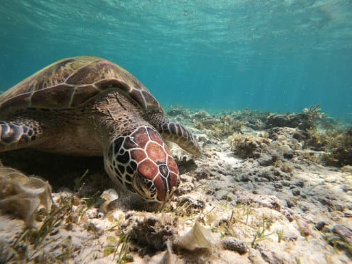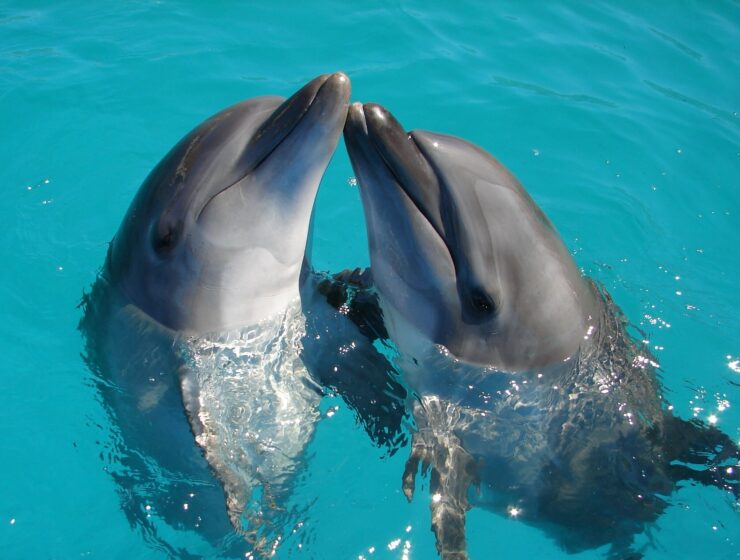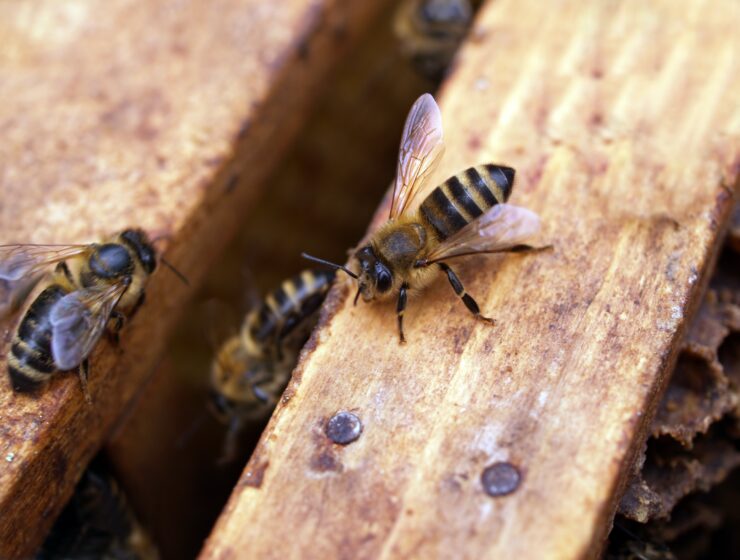Dolphins are active and highly intelligent mammals that need a balanced and nutritional diet, just like people. Dolphins need a variety of nutrients to maintain their health, such as vitamins, proteins, and minerals. Dolphins require a high-calorie diet to support their energetic and playful lifestyle, and for activities like swimming, jumping, diving, and playing with other dolphins. Researchers have found that adult dolphins require 33,000 calories a day, much more than a person requires which is around 2,000 calories per day.

Like other mammals, their diets change based on their stages of life. The diet of a baby dolphin, also known as a calf, is very different than an adult dolphin’s diet.
Calves only feed on their mother’s milk when they are born, which is rich in nutrients and is very important to their growth and development. As they grow older, calves will transition to solid foods, just human babies, and begin to learn to hunt wild prey.
Marine animal diets may change upon being rescued, but that is not to say the quality of their diet changes. Aquarium diets are still extremely nutritious and are monitored and refined by a biologist.
Keep reading to learn more about diets in the wild and diets in rehabilitation.
Hunting Prey
As calves grow up, they learn how to hunt for their prey in the ocean depths. Dolphins have many ways of capturing their prey, like quickly chasing down a fish to catch and eat!
Another method of hunting is known as Kerplunking, a method of hunting dolphins use to scare or stun a fish. Dolphins quickly slap their large fins near a fish, instantly stunning the fish and then capturing it to eat. This also drives fish away from their hiding places, making them easier to catch.
Some dolphins use tools to hunt their prey. A recent discovery found female bottlenose dolphins in western Australian seas use sea sponges to protect their nose when hunting fish under rocks.
Dolphins might hunt alone or as a pod (a group of dolphins). When dolphins hunt in a pod, they typically herd and corral their prey. If a pod comes across a large school of fish, the dolphins will surround the school of fish and herd it into a ball. After the fish have formed a ball, the dolphins take turns rushing the center of the ball and eating as much fish as possible. This is one of the popular methods of dolphin feeding!

Diets of Wild Dolphins
Dolphins are primarily carnivores, which means the main staple in their diet is meat. Some of the favorite things for a dolphin to eat are types are fish like mackerel, herring, sardines, and sometimes even larger fish like swordfish and tuna! Other dolphin favorites include squid, octopus, and cuttlefish.
A dolphin’s diet can vary based on their geographical location. For example, coastal dolphins, like the bottlenose and spinner dolphin, prefer fish that hang out on the bottom of the sea floor.
Sea Turtle Diets
Another popular resident of the Clearwater Marine Aquarium are the sea turtles! Like a dolphin’s diet, a sea turtles’ diet will differ based on their stages of life and by species of turtle. Baby sea turtles, also known as hatchlings, follow a more carnivorous diet than adult sea turtles. Hatchlings are born in the shore’s sand and enjoy eating small animals that live in between seaweed mats on shore.

Most adult sea turtles are omnivores, meaning their diet is a mix of meat and vegetation.
The Loggerhead Sea Turtle has strong jaws, therefore their diet primarily consists of primarily of crabs, clams, mussels and other hard shell animals found on the ocean floor.
Leatherback Sea Turtles prefer jellyfish, and other soft bodied animals because of their uniquely adapted mouths and throat that allow them to swallow slippery prey.
The Hawksbill Sea Turtle have narrow heads and beak-like mouths that allow them to hunt prey in small crevices in the coral reefs. Their diet is primarily made-up of sea sponges, sea anemones, and jellyfish.
The Green Sea Turtle is mostly herbivorous, eating mostly seagrasses and algae.
Challenges With a Rehabilitation Diet
When marine animals like dolphins or sea turtles go into rehabilitation, they often arrive with health issues like an illness, injuries, or malnutrition. One of the challenges for rehabilitation centers such as Clearwater Marine Aquarium is formulating a diet that addresses nutritional needs and helps in the animal’s recovery.
It is very important for rehabilitation staff to quickly formulate a marine diet that has the right balance of nutrients while accommodating for any injuries or illness. For example, a malnourished dolphin may require a diet high in fat and protein; and a sea turtle with fibropapillomatosis may require a diet consisting of easily digestible food.
Another challenge can sometimes be that a favorite food (fish) is not available like it is in the wild. In rehabilitation, diets might include a variety of fish species to ensure a more complete nutrient profile and to ensure their diet needs are being met.
Be sure to attend the next K12 Virtual Field Trip to Clearwater Marine Aquarium to learn more about CMA’s fish kitchen, and the specialized diets their residents enjoy!
The Fin-ishing Touches
To wrap up, it’s important to remember dolphins, and other marine animals, require a specialized diet for maintaining their energetic and playful lifestyle. Dolphins are carnivorous and their diet consists primarily of meat such as fish, squid, and other small sea creatures.
Dolphins may hunt alone or as a pod and have different methods for hunting, some dolphins even use tools! The diet of a dolphin and a sea turtle will vary based on its life stage, where it lives, and if it’s recovering from an injury. It’s very important for marine rehabilitation staff to customize marine diets that are nutritionally balanced and will help in their recovery journey. While there may be differences in the diets of marine animals in the wild in marine animals in rehabilitation, it’s always important they have a high quality diet that supports their health and well-being.
We hope you join us on November 8th for CMA: Feeding Frenzy, a K12 virtual field trip open to all students in grades K – 12. You can register by clicking here!



